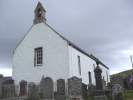| A History of
the Church in Rogart By The Rev J. L Goskirk The Christian Gospel was first preached in what was to become the parish of Rogart Foundation of the Church in the 7th Century. During that period missionaries from those areas of Scotland in which the Faith was already established- and also from Ireland - reached the district. One of these was Callan (Latin - Culalinus) who appears to have made Strathfleet and the area stretching up towards Strathbrora the sphere of his work. The site of a Chapel of St Callan lies on the bank of the River Fleet near Kinnauld and there was also a chapel at Rovie with a burial ground which remained in use for many centuries.
The parish of Rogart takes its name from the place where the present St Callan's church is situated. In earlier days this was often referred to as Rogartmore or Big rogart (also Muckle rogart) and. of course, the town ship of Little rogart lies opposite. The meaning of the name may now be impossible to define and experts vary in their suggestions. In the First Statistical Account, 1780, it was stated that the original name was Roghard, meaning in Gaelic "very high". The Second Statistical Acccount, 1835 suggested Rhidheard - from two Gaelic words - Rhide - an inclined plain, and Ard - high.. The author of 'Sutherland and the Reay Country' says "early characters give Rothgorthe, known in highland topography- Rothe, a circle, and Gorthe, a cultivated land". when we stand at St. Callan's Church and face west we are certainly looking down on a rough circle of land bounded by the hills behind us and those beyond Little Rogart and Rheidchalmie. It seems a very reasonable description of the vicinity - the low lying area of marshy ground with the hills encircling it on all sides, but any of the theories would fit. Foundation of the Church The church was by no means centrally situated in the parish, being for centuries even nearer the boundary between Rogart and Dornoch than it is today, for Kinnauld was, until comparitively recently, in the latter parish. According to an ancient legend the site was chosen by somewhat unorthodox means. Two white horses, each drawing sledges, one bearing a heavy stone and the other a Bible, were set loose from a given point. The course covered by the first horse marked the boundaries of the glebe, while the place where the second horse halted was where the Church was erected. However, the choice was made, the fact that it is easily accessible from every part of the parish with roads leading in from Langwell, Morness, Rhilochan, the western end of Strath Fleet by way of Pitfure and Little Rogart, and from Pittentrail. Indeed it is noteworthy that the Church is actually visible from Milton Muie - about five miles away as the crow flies. Originally, and for many generations the church would have been a simple stone building with a roof of heather thatch and only the simplest of furnishings. A common idea that Scottish mediaeval parish kirks were miniature reproductions of the Cathedral and monastic ones is completely at variance with fact. As George Hay states in 'The Architecture of Scottish Post-Reformation Churches', "From the 13th Century onward the most common type of church plan was a simple aisleless rectangle often of rather attenuated proportions." Over the years repairs and alterations must have been required but there is no record of any of these. The Highlands were primitive and unsettled places in the mediaeval period. What records do survive relate to the Cathedrals and Monasteries and not to the humble parish churches. We know however that in the diocese of Caithness, fourteen of the parish churches were assigned for the maintenance of the Canons. One of these was the chancellor to whom was given the Church of Rogart. The Reformation In Scotland 1560
It is virtually certain then that St.Callans continued in use, being altered only to suit it as a place of Protestant, rather than Roman Catholic, worship. But again it must simply be said that we have no record of any of these alterations or of any repairs or improvements until the first decades of the 18th Century. By then the Kirk of Rogart, as it was now known, was in a very bad state of repair - a condition it shared with almost every other parish church in the county. It was the responsibility of the Heritors - the landowners of the parish - to provide and maintain churches and manses, but this they were often unwilling to do. By this period however, the Presbyterian system was firmly established and the Presbytery (of Dornoch) began to make itself heard in the matter. In 1736, the minister of Rogart, the Rev John Munro, reported to the Presbytery that despite an official visitation which had taken place some years before, the Heritors had done nothing. To be continued........................................................... |
